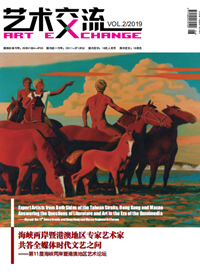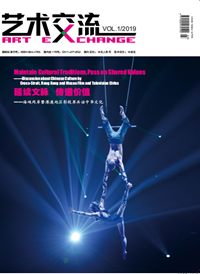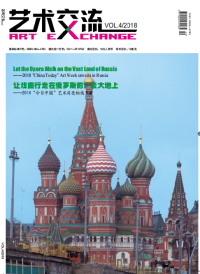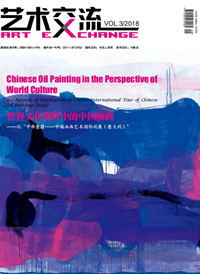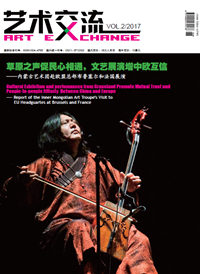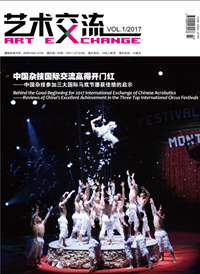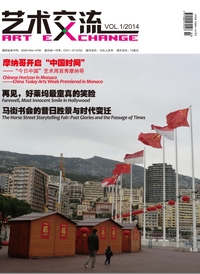Three-decade of In & Out Palace, Unique Serendipity with Chinese Culture
Exclusive interview with Chou Kung-shin, former President of Taipei Palace Museu

Chou Kung-shin
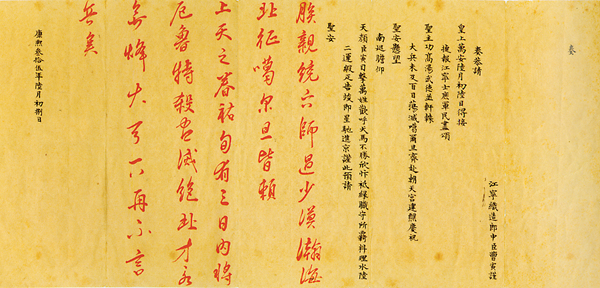
With the help of the collection of cultural relics, Taipei's "Palace Museum" has presented a number of most popular cultural and creative products. The photo shows the memorial of Cao Yin, an official in charge of textile industry in Jiangning, collected by the "Palace Museum" in Taipei.
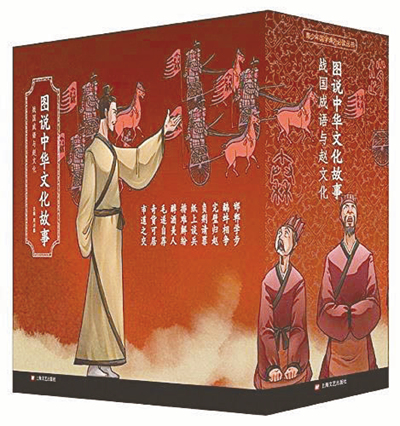
In recent years, Chou Kung-shin has devoted herself to the promotion of Chinese culture and has compiled the book series Stories of Chinese Culture.
Entering the Taipei Palace Museum (hereafter referred to as the "Palace" in Taipei) in her 20s, she considers herself a veteran "maid of honor" after 30-year working in the Palace, growing up from the lecturer to the president, through self-deprecation; the Palace has become "younger" since the application of reforms, with the generating parties for all people at weekends, fascinating cultural industry winning great popularity on the Internet and always becoming hottest topic; Through her efforts, Taipei's "Palace" ranks among the top ten most popular museums in the world, constantly refreshing the value of cultural and creative industries; in the meantime, there were several exhibitions that have sensationalized the world of Chinese people under her coordination, the most famous was especially in June 2011, when the union of "Dwelling in the Fuchun Mountains" after over 360-year separation has attracted more than 500,000 spectators in less than two months, a renowned "business record" in industry; she was more able to, withstanding the pressure, realise the first exchange of visit by the "Palaces" on both sides of the Taiwan Straits, profoundly promoting the cultural exchanges between the two sides.
She is Chou Kung-shin.
When meeting wth Chou Kung-shin for the first time, her first impression to us was elegance and calmness, and that kind of elegance with poetry and self-satisfying calmness and gentleness coming from her deep cultivation in education - Bachelor of French, Fu Jen Catholic University, Taiwan, Master of "Institute of Art History under Chinese Culture University" and Ph.D., Art History and Archaeology, University of Paris IV, France. Such academic background has allowed her to work "in the palace" for more than 30 years, and enabled her to "proficiently manipulate" Taipei's "Palace"; even after being "out of the Palace", she still adheres to her own beautiful vision - committed to the inheritance and promotion of Chinese traditional culture. Taipei's "Palace" has changed its image of "profoundness" in recent years, becoming more "lively" and "lighter", even with some "cutie"."Young people like moving subjects, but cultural relics are static. How can we get more young people to come to the museum?" Zhou Gongxin's answer is to make the museum "alive".
Make Museums "Alive"
Reporter: You once compared yourself to the "maid of honor" in the "Palace" in Taipei in some interviews. In the past 30 years, what do you think is the reason behind the "unprecedented popularity" of Taipei's "Palace", which equals to that of the urban night market?
Chou Kung-shin: I have been serving in the "Palace" in Taipei for 31 years in total since the age of 25, it can be roughly divided into two stages - from 1972 to 1999 as "first entry into the palace"; from 2008 to 2012 "return to the palace". Since taking the undergraduate major of French, I started my foreign language lecture at the "Palace" in Taipei. From the second year on, I worked at the President's Office, and then I became the director of the "Palace" exhibition education group, responsible for exhibition education and external public relations. During this period, I accumulated some basic experience in exhibition education. However, in view of the shortage of professionals in the museum, I left the "Palace" in 1999 and returned to the alma mater, Fu Jen University, to establish the Institute of Museum Studies. In 2008, I again returned to the "Palace" to do promotion work.
In the first stage, I have already laid a certain foundation for public education and various activities for the people in the "Palace" in Taipei, but those activities did not develop well. When I returned, I made some changes.
Unlike machines, audiences' needs are actually various, so we can't "discriminate", but hold the attitude of "diversified changes". The "Palace" in Taipei implements the categories in terms of age and diversity for the audiences, meaning that designing different activities according to different age groups and educational cognition backgrounds. For children, we offer experience and creative events; in the face of teenagers, we set up summer camps; for adults, we also divide them into women and people with physical and mental disabilities, carrying out targeted activities based on their characteristics. In addition, the cultural relics collected in Taipei's "Palace" are also world-famous with great value. Therefore, under such circumstances, more people are attracted here.
Reporter: On the issue of how to connect museums with contemporary life, museums around the world are exploring how to make it “alive”, but few could boldly bring the activities for young people, like the carnival, into the museum. But these elements are found in this "Palace". Have you ever been worried when you are making these attempts? Do you think this is effective in bringing the traditional culture of the museum into the hearts of children and young people?
Chou Kung-shin: There is nothing to worry about. After grasping the educational theory of the museum to a certain extent and having a certain understanding of the educational practices, we know what to do to really make the museum "alive". It is critically important to have a deep understanding of the museum profession, which is why I have returned to Fu Jen University to establish a museum research institute.
Cultural relics are of times and history. Therefore, for children and young people, there is a distance between them and cultural relics, but these new activities are very lively and diverse in design, allowing them to establish an artistic understanding of art culture and cultural relics through maneuvering. Moreover, these activities are held every year, so that there will be accumulation. Through this accumulative understanding of cultural relics, the previous distance will be reduced when we admire the cultural relics again, so that the traditional culture in the museum can enter the hearts of children and young people.
In 2013, the team of cultural innovation of the "Palace" in Taipei used Kangxi's handwriting as a blueprint to design a "I(the emperor) know" tape. It became an online heat once launched to the market and most popular in platforms of Weibo and WeChat. Today, it is still a favorite expression pack for many young people.
Behind the "Heat" of Products of Cultural Innovation
Reporter: Some Internet users say the cultural innovation of Taipei's "Palace" is "toxic", a joke though, but it reflects the public's love for the cultural and creative products of the "Palace" in Taipei. Can you give us some experience in this perspective?
Chou Kung-shin: After I returned to work in 2008, I immediately planned the program named "Taipei 'Palace' Cultural and Creative Industry Training Camp". First of all, we divide all walks of life into several major parts, such as traditional industry, textile industry, science and technology industry, etc. We then carry out training program for people in various industrial systems in groups. They are specifically designers, accountants, marketing staff and GM from various industries, as they all play a very important role in the company's manufacturing process.
For example, if a designer wants to design a product with the enamel porcelain elements of Emperor Yongzheng of the Qing dynasty, he needs to know the specific style of ceramics in that period, the definition of beauty and its characteristics, the marketing staff needs to know the audiences, accountants need to calculate the cost and profit, and the general manager needs to acknowledge the market situation... The training camp is dedicated to solving these problems. After a complete training, four members of each team shall already plan the business model, every time a good idea emerges.
On the other hand, they can think about products from different angles via discussion. For example, what can be done in addition to ceramics in the aesthetic style of the Yongzheng period? What happens when it changes a bit based on the style of Yongzheng? The cultural relics left by the predecessors have become the living source of their creation. Discovering the wisdom, techniques, and design of the ancients, plus their own ideas, it could form an industry that makes life better after designing it into products that are now available and closely related to everyday life. At present, the camps have opened five sessions of training, with at least six or seven hundred trainees.
Reporter: How are the courses of the camp set up?
Chou Kung-shin: I split the courses into three stages.
The first stage is to turn on perception. Perception here refers to people's five senses - vision, hearing, smelling, touching and tasting. The course takes them to experience everything in nature and how to see, hear, smell, taste and touch. The division of disciplines Started in the 18th century, but the disciplines are categorized in a too specific manner. After entering a particular subject, our perception will be too strong in some sense, while the shall be weakened, so we need to wake up these senses again, open all the perception and improve the comprehensive aesthetics.
The second stage is a two-month learning of cultural relics. After opening the five senses, everyone will find their own way to acquire beauty, only at this time can people better understand the essence of beauty. Therefore, since the starting of this period, the perception will be most keen, especially for designers. At this time, more elements will be ingested after learning the cultural relics, and the works will be more diversified and unique.
The third stage is to produce via joint efforts. All personnel are involved in the production, a group composed of a few people will carry out brainstorming, and after designing a fine subject, we shall invite relevant experts for guidance and review.
Reporter: Will the "Palace" in Taipei cooperate with the team that has been forged by the training camp?
Chou Kung-shin: We will choose the best products they have made here, specifically in terms of cooperation of "double brand" with them. Of course, it doesn't matter even if they don't choose "double brand" cooperation. Some people may ask, what benefits can we get from it? We have trained them, they better design, sell better products, it will create more taxes.
Every year, we shall cooperate with many manufacturers from the camp, each of them can create dozens of cultural and creative products on a yearly basis. In 2008, there were more than 2,000 cultural and creative products in Taipei's "Palace", and there were over 5,000 categories when I left. As most products are deeply connected with everyday life, many customers buy them in large quantities. The annual output value of the cultural and creative products of "Palace" in Taipei has reached NT$360 million, and has now reached more than NT$1 billion.
When Chou Kung-shin studied French and then determined to step onto the global stage as an international person a world person. She travelled around the world, and eventually became an active supporter of traditional culture. After being "out of palace", she devoted herself to the "Stories of Chinese Culture". "Using a medium like idioms to spread the seeds of Chinese culture to the hearts of Chinese people, especially the young, providing them with a high-quality auxiliary reading materials integrating knowledge, culture, morality and aesthetic education." For this vision, she even sold out her real estates in Taiwan.
Continue Her Work After Retirement
Reporter: You have been dealing with art and traditional Chinese culture all your life. After "going out of the palace", is your focus still on this aspect?
Chou Kung-shin: The "Palace" in Taipei has cultivated me for 31 years, which is very rare. I have been committed to exhibiting and educating these years, which have increased my theoretical accumulation. In 2012, I could have been the head of the Taipei "Palace" for additional four years, but I would like to take some time to do the work on Chinese culture dedicated to the general public, and I have applied for retirement in 2012.
I have composed a series of "Stories of Chinese Culture". Some say that it is a dying business to do actual books. Many people choose to go online without reading books. Why do you want to publish books? In my opinion, first of all, books can be collected. Moreover, what I want to do is a book about young people's learning traditional culture, make them better return to the tradition.
Reporter: Why do you intend to face this group of teenagers directly?
Chou Kung-shin: Adolescents are still developing, and they have acquired certain skills of writing. They are also in the golden period of personality shaping. Giving them good guidance during this particular period will generate a profound impact on their future. They will transform these into their own wisdom, and integrate into their own personality, which is very helpful for restraining their own behavior, enhancing their self-confidence and even enhancing the overall national confidence. However, it has always been a question for me as to how to guide the young to systematically study Chinese history and culture in an era of trivial knowledge and information flooding.
I believe that most of the young people can now recite many idioms, but lacking a comprehensive understanding of context and social background. However, the essence of idioms is historical facts, a historical reality. I hope that, through idioms, young people can understand that era further.
Reporter: There are too many things in an era, from the social background of the times, the political situation, to the costumes, etc. How to let the teenagers return to that era through books?
Chou Kung-shin: In the "Stories of Chinese Culture" series, taking the "Learn to Walk in Handan" in the Warring States Period for example, we first introduce the background of the story, and later explain the idiom according to the text and illustrations. And we have devoted much effort in the pictures - according to the bronze warrior statue unearthed from the watershed in Changzhi City, Shanxi Province, it can be estimated that straight dress and short jacket were the common garment for the ordinary people; it could illustrate the Xuanduan Crown was commonly used for the officials of the Warring States Period based upon the Picture of Newly-made Etiquette; and the common screen styles for interior decoration in the Warring States Period by referring to the painted wooden doubledragon screen unearthed from the No.1 tomb of Tianxingguan in Jiangling County, Hubei Province…Every detail in the picture is drawn according to the unearthed cultural relics and materials, endeavoring to restore all aspects of that era.
Reporter: Although books have their merits, it has to be said that e-reading is the mainstream trend nowadays. Will you consider sending this series of books to the Internet to obtain a larger amount of communication? What other plans do you have?
Chou Kung-shin: We did give it a thought. Online reading has its obvious advantages - large capacity and wide range of communication. At present, we have developed a WeChat applet, and an App will be launched soon. Although we are still on the road to the Internet, we also hope that it can be different from ordinary fragmented reading. We have made comics based on the materials of each idiom and story, and we also have interesting tests and small games after the comics were played afterwards, so that young people can form a systematic knowledge system via online reading. We plan to introduce the "Stories of Chinese Culture" into the students' classroom, and through the guidance of teachers, it allows the children to acquire more traditional knowledge through more interesting methods of learning.



